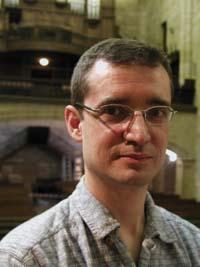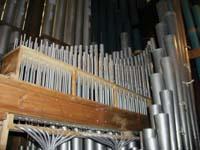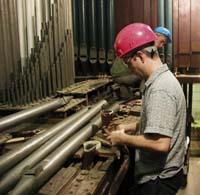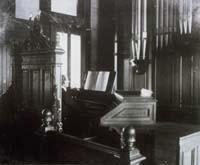The organ of Usurbil blows again

To do this, experts reflect on the changes that can be introduced in the improvement of the organ with which they play this instrument, organists. For the good development of the work, collaboration between organists and experts with extensive experience and knowledge in restoration is essential.
The organ manufacturer selected for the restoration of the organ of Usurbil --DLFO (Manufacture d'Orgues) - is a company with extensive experience in the restoration of French romantic organs. The main objective of the process is to return to the original organ - that is, the sound and technical contributions of Mutin, adapted by Fernand Prince in 1920-, and incorporate new and adequate sound possibilities to the organ style, without prejudice to its structure.
It is a long process. They will be approximately 10,000 hours of work. This is a team of seven people who began to disassemble the organ on September 13. The head of the project is Denis Lacorre, who, for example, after the complete disassembly of the organ, takes several weeks to think and decide the way forward in the restoration work, to explain to the organists what they will do and consult with them different questions. According to him, "restoration work has several stages and at the same time we have more than one job in order not to interrupt work."
Special features Special features

This organ has two important origins, which are more important. It was basically a room organ. However, his transfer to the church of Usurbil suffered various transformations, becoming an ecclesiastical organ. Although it currently preserves some of the characteristics of the room organ, the objective is not to recover that origin.
Objective XIX. It is about recovering his French symphonic style at the beginning of the twentieth century, always maintaining the character of Cavaillé-Coll. Among other things, it is intended to carry forward the front handrail (approximately one meter or a half meter) and turn the contour. In this way, it would remain as it was in its day, that is, the organist would head towards the organ and the relationship between the director and the organist would be narrower.
Likewise, the Usurbil organ has original and peculiar technical characteristics, which are not only similar in our environment but in the rest of the State. The hand keyboards have 64 notes and the pedals 34. In Spain there is no organ that has the same keyboard extension as that of Usurbil.
Likewise, the five original adjustable combinations of Mutin are elements of great interest to all organists and organists. If the organist wants to change sonority while playing the organ, pressing a pedal change the prepared combinations and the sounds change.

Until emptying the inside of the organ
The organ has been dismantled piece by piece. Until leaving the box empty. Undoubtedly, they know that it is a unique manufacturing organ. However, they have seen that some elements of wood are eaten by pipes, so you have to renew them. In addition, Denis Lacor did not think the pipe would get so deep, "but we are very used to this problem."
It seems a complex work, but the disassembly of the organ is relatively simple, as long as the instrument itself is well known. In general they follow a methodology. French expert Denis Lacorre learned this methodology with other organisers and, in short, highlights that it is something that you learn to do and do. "Today it seemed to me a reflection". There is no doubt that attention must be paid to the characteristics of each instrument, but, with the custom, it affirms that the work is done almost spontaneously.
Inside the organ there are numerous elements, each of them of large size. First of all, all the essential elements (bellows, mechanical parts, wind boxes, expression boxes, pipe and consolo) will be cleaned from top to bottom. All parts of mechanics and bellows must be dismantled and renewed.

The organ box is the only element that will be practically intact. It is of oak and structure of pine carrasco (fir with red threads, very hard). They will remove dust from the body of organs and structure, giving them an antipolyl and mold treatment. Cabinetmaking, on the other hand, is a nourishing liquid. A solid wooden ceiling will be manufactured to protect the central organ, the pedal and the sound of the most homogeneous games.
The restoration of wind boxes or secrets is perhaps the most important part for the proper functioning of the organ. To make the wind boxes reliable, it is necessary to completely renew them. And it is that the organ works by the wind. Therefore, it is essential to provide at all times enough wind to produce sound. The scarce or unstable supply of wind can cause serious problems. For this reason, the wind power systems have progressively been improved to improve their supply and achieve a continuous and stable flow. On the one hand, they collect atmospheric air and compress it to distribute it properly. In short, it is a system of capture and storage of air.
The secrets direct the compressed air to the tubes. In the secrets there are many tubes to which everything has to be very well calculated for the wind to arrive. That is, it should not have any wind leaks. These secrets have never been opened, someone knows what they will find in them. These secret tubes are made with special skin, such as kid's skin. When the goat is germinated, an abortion occurs so that the skin of the kid does not have hair.
Denis Lacor believes that each secret will take about 600 hours to restore. After opening and restoration, these oak boxes are closed with a special glue. They use, among other things, the tail made with bones and nerves of cows or rabbit leather. They use organic tails instead of synthetic.

Do, re, mi...
In the restoration of an organ, perhaps the most complex work from a technical point of view is the final delight to get the best out of the instrument. This usually lasts a lot and usually leave these definitions for the end. And it is that experts must reflect with organists and with those who really know the organs of the house.
As far as harmonization is concerned, Prince did an excellent previous work, which traced and harmonized the instrument of Usurbil. As a result, the 1920 organ has been preserved almost entirely. It has an aesthetic of Cavaillé-Coll and not the sound of the Mutines of the 1920s -the timbres were hard and disproportionate. The size of the tubes, carving and materials provide a noble and deep sound. As Prince himself said, the best sound is obtained after passing the organs by the hands of the harmonist.

Once the dismantling and restoration work has been completed, all this must be traced back. According to the French expert, the reconstruction is somewhat more complicated. In fact, each instrument is different and they have to find their limits to get the best result. "The control of the limits of each instrument is fundamental for a better sound and keyboard touch".
The process is long, but once the work is finished, some changes in the organ will be observed. Among other things, there will be no wind leaks, so the sound will be cleaner, that is, sweeter and homogeneous throughout the record. Likewise, they want to enrich the organ with different games of symphonic style, the XIX. Late twentieth century To host a wide repertoire of great composers from the beginning of the century. To do this, they will incorporate games of great power and the organ will be stronger. Its timbre is more round and offers a wider range of games. It will take approximately two years to listen to the pieces played in the organ of Usurbil, but it will be worth it.







